Gbaida
Trap in the farm fence (fufu or gbaisansa)
For cutting-grass, porcupines or squirrels
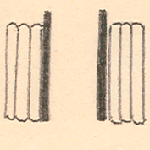 Two sticks, called pwin kכnε, are placed in a gap in the fence. The distance between them is measured by the distance between the finger and the thumb. Two sticks, called pwin kכnε, are placed in a gap in the fence. The distance between them is measured by the distance between the finger and the thumb.
|
Sodiŋgbai
Snare near a hole
For rats and squirrels
 Needed: A short forked stick with one prong longer Needed: A short forked stick with one prong longer than the other. A trapstick, with a cord tied to the top. The bottom of the cord should have a slipknot noose, and not far from the top, a short stick (1-1/2 - inches) should be tied. than the other. A trapstick, with a cord tied to the top. The bottom of the cord should have a slipknot noose, and not far from the top, a short stick (1-1/2 - inches) should be tied.
|
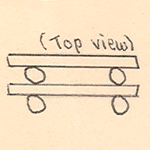 Two more sticks are placed in front of the original two, spaced up to an inch away. Two more sticks are placed in front of the original two, spaced up to an inch away.
|
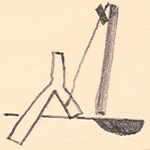 The kaŋgai, secured but unset. The kaŋgai, secured but unset.
|
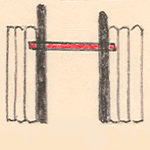 Two crosspieces are placed behind each pair of vertical sticks. All are then tied together with raffia twine. Two crosspieces are placed behind each pair of vertical sticks. All are then tied together with raffia twine.
|
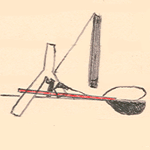 Trap is set, as with gbaida. The noose is spread out around the perimeter of the hold. The kככsa is attached to some food, such as cassava, so that the rat, nibbling on it in the hole, will pull it, releasing the pεŋga and the trap stock. The noose will snare the animal on the opposite side of the stick where the cord it drawn. Trap is set, as with gbaida. The noose is spread out around the perimeter of the hold. The kככsa is attached to some food, such as cassava, so that the rat, nibbling on it in the hole, will pull it, releasing the pεŋga and the trap stock. The noose will snare the animal on the opposite side of the stick where the cord it drawn.
|
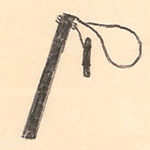 A trapstick (gbaikכnε), made from one flexible sapling or two tied together, is pounded into the ground. Around the top, a string is tied. The other end is tied to a short stick (pεŋga). The noose (gbai yuu), made from wire, is attached to the top. A trapstick (gbaikכnε), made from one flexible sapling or two tied together, is pounded into the ground. Around the top, a string is tied. The other end is tied to a short stick (pεŋga). The noose (gbai yuu), made from wire, is attached to the top.
|
Kanjuu
"Neck rope"
For deer
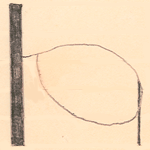 The trapstick should be long and thick, and not securedly fasted in the ground. The animal will then drag it along, leaving a trail and probably getting stuck somewhere. A firmly rooted stick might break, allowing the animal to escape. Another light stick is used to hold up the other side of the noose. The trap is placed across a “kpee”, a path used by animals. The trapstick should be long and thick, and not securedly fasted in the ground. The animal will then drag it along, leaving a trail and probably getting stuck somewhere. A firmly rooted stick might break, allowing the animal to escape. Another light stick is used to hold up the other side of the noose. The trap is placed across a “kpee”, a path used by animals.
|
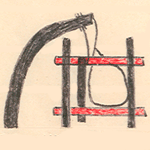 Another stick (kככsa) is laid horizontally at the bottom of the trap. The pεŋga is then inserted with the top in front of the kaŋgai but behind the kככsa, under tension so that when the kככsa is pushed down the pεŋga will snap forward and release the trapstick. The noose is suspended between the two kaŋgai, behind or beside the pεŋga, so that on release the pεŋga will not be ensnared in the noose and allow the animal to escape. Another stick (kככsa) is laid horizontally at the bottom of the trap. The pεŋga is then inserted with the top in front of the kaŋgai but behind the kככsa, under tension so that when the kככsa is pushed down the pεŋga will snap forward and release the trapstick. The noose is suspended between the two kaŋgai, behind or beside the pεŋga, so that on release the pεŋga will not be ensnared in the noose and allow the animal to escape.
|
|